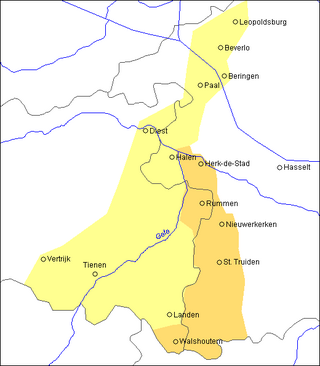A lateral is a consonant in which the airstream proceeds along one or both of the sides of the tongue, but it is blocked by the tongue from going through the middle of the mouth. An example of a lateral consonant is the English L, as in Larry. Lateral consonants contrast with central consonants, in which the airstream flows through the center of the mouth.
In phonetics, rhotic consonants, or "R-like" sounds, are liquid consonants that are traditionally represented orthographically by symbols derived from the Greek letter rho, including ⟨R⟩, ⟨r⟩ in the Latin script and ⟨Р⟩, ⟨p⟩ in the Cyrillic script. They are transcribed in the International Phonetic Alphabet by upper- or lower-case variants of Roman ⟨R⟩, ⟨r⟩: ⟨r⟩, ⟨ɾ⟩, ⟨ɹ⟩, ⟨ɻ⟩, ⟨ʀ⟩, ⟨ʁ⟩, ⟨ɽ⟩, and ⟨ɺ⟩ as well as by the lower-case turned Roman ⟨a⟩ combined with the "non-syllabic" diacritic, that is ⟨ɐ̯⟩.
The phonology of Standard German is the standard pronunciation or accent of the German language. It deals with current phonology and phonetics as well as with historical developments thereof as well as the geographical variants and the influence of German dialects.
The phonology of Catalan, a Romance language, has a certain degree of dialectal variation. Although there are two standard varieties, one based on Central Eastern dialect and another one based on South-Western or Valencian dialect, this article deals with features of all or most dialects, as well as regional pronunciation differences. Various studies have focused on different Catalan varieties; for example, Wheeler and Mascaró analyze Central Eastern varieties, the former focusing on the educated speech of Barcelona and the latter focusing more on the vernacular of Barcelona, and Recasens does a careful phonetic study of Central Eastern Catalan.
The sound system of Norwegian resembles that of Swedish. There is considerable variation among the dialects, and all pronunciations are considered by official policy to be equally correct – there is no official spoken standard, although it can be said that Eastern Norwegian Bokmål speech has an unofficial spoken standard, called Urban East Norwegian or Standard East Norwegian, loosely based on the speech of the literate classes of the Oslo area. This variant is the most common one taught to foreign students.
Martuthunira is an extinct Australian Aboriginal language, that was the traditional language of the Martuthunira people of Western Australia.
The Persian language has between six and eight vowels and 26 consonants. It features contrastive stress and syllable-final consonant clusters.
The phonological system of the Polish language is similar in many ways to those of other Slavic languages, although there are some characteristic features found in only a few other languages of the family, such as contrasting postalveolar and alveolo-palatal fricatives and affricates. The vowel system is relatively simple, with just six oral monophthongs and arguably two nasals in traditional speech, while the consonant system is much more complex.

Shipibo is a Panoan language spoken in Peru and Brazil by approximately 26,000 speakers. Shipibo is an official language of Peru.
Dutch phonology is similar to that of other West Germanic languages, especially Afrikaans and West Frisian.
This article is about the phonology and phonetics of the Estonian language.
Wahgi is a Trans–New Guinea language of the Chimbu–Wahgi branch spoken by approximately 100,000 people in the highlands of Papua New Guinea. Like other Chimbu languages, Wahgi has some unusual lateral consonants.
This article is about the phonology and phonetics of the Slovak language.
The phonology of Faroese has an inventory similar to the closely related Icelandic language, but markedly different processes differentiate the two. Similarities include an aspiration contrast in stop consonants, the retention of front rounded vowels and vowel quality changes instead of vowel length distinctions.
This article covers the phonology of the Orsmaal-Gussenhoven dialect, a variety of Getelands spoken in Orsmaal-Gussenhoven, a village in the Linter municipality.
Weert dialect or Weert Limburgish is the city dialect and variant of Limburgish spoken in the Dutch city of Weert alongside Standard language. All of its speakers are bilingual with standard Dutch. There are two varieties of the dialect: rural and urban. The latter is called Stadsweerts in Standard Dutch and Stadswieërts in the city dialect. Van der Looij gives the Dutch name buitenijen for the peripheral dialect.
This article covers the phonology of the Kerkrade dialect, a West Ripuarian language variety spoken in parts of the Kerkrade municipality in the Netherlands and Herzogenrath in Germany.

Getelands or West Getelands is a South Brabantian dialect spoken in the eastern part of Flemish Brabant as well as the western part of Limburg in Belgium. It is a transitional dialect between South Brabantian and West Limburgish.
The phonology of the Maastrichtian dialect, especially with regards to vowels is quite extensive due to the dialect's tonal nature.


